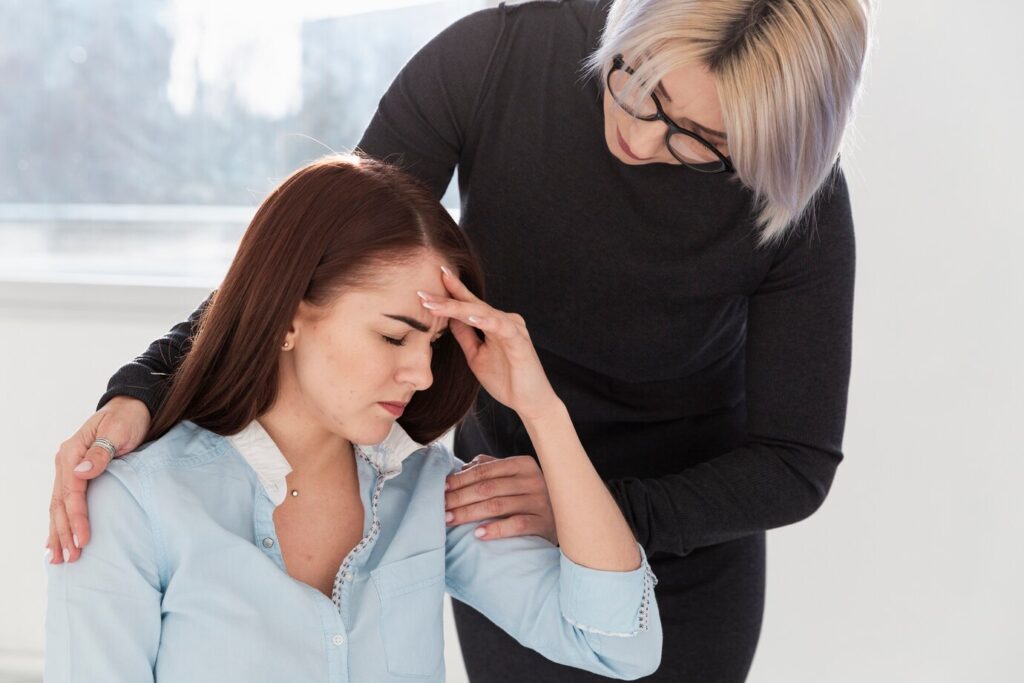Women Differently
Bipolar disorder is a complex mental health condition that affects millions of people worldwide. Known for causing extreme mood swings, bipolar disorder can significantly impact an individual’s personal, social, and professional life. While the disorder is often considered a universal condition, its manifestation and impact can differ greatly between men and women. This blog explores how bipolar disorder affects women differently, with a focus on the gender-specific symptoms, risks, and treatment approaches that are critical for understanding and managing this condition in females.
Understanding how bipolar disorder symptoms in females manifest differently from males can significantly improve diagnosis and treatment outcomes. It’s important to recognize the unique ways this mental health condition affects women, allowing for more tailored and effective interventions.
Understanding Bipolar Disorder
Definition and Key Characteristics
Bipolar disorder is a mental health condition characterized by extreme mood fluctuations, ranging from manic or hypomanic episodes (elevated mood) to depressive episodes (low mood). These mood swings are often intense and can disrupt relationships, work, and overall daily functioning.
- Manic Episodes: During a manic episode, individuals may experience elevated or irritable moods, increased energy, impulsive behavior, racing thoughts, and a reduced need for sleep. This state can lead to risky behavior, poor decision-making, and a sense of invincibility.
- Depressive Episodes: In contrast, depressive episodes are characterized by feelings of sadness, hopelessness, fatigue, low energy, difficulty concentrating, and suicidal thoughts.
- Mixed Episodes: A mixed episode occurs when symptoms of both mania and depression occur simultaneously, making it extremely challenging to manage emotions and behavior.
Bipolar disorder is typically divided into three primary types:
- Bipolar I Disorder: Involves manic episodes that last at least seven days or are so severe that immediate hospital care is required. Depressive episodes typically last at least two weeks.
- Bipolar II Disorder: Characterized by a pattern of depressive episodes and hypomanic episodes (a less severe form of mania).
- Cyclothymia: This involves periods of hypomanic symptoms as well as periods of depressive symptoms lasting for at least two years but without meeting the full criteria for a manic or depressive episode.
Common Onset and Prevalence in Women
Bipolar disorder often manifests in late adolescence or early adulthood, with women typically experiencing onset later than men. Research shows that bipolar disorder is equally prevalent in both men and women. However, women tend to have a different experience with the disorder, especially in terms of the symptoms, triggers, and outcomes. Understanding how bipolar disorder symptoms in females differ from those in males can help with timely and accurate diagnosis and intervention.
Symptoms of Bipolar Disorder
Bipolar disorder presents a variety of symptoms, ranging from manic episodes to depressive states. These symptoms can be particularly challenging for women, as they may experience them in unique ways due to hormonal fluctuations, life stages, and social factors.
Manic and Hypomanic Symptoms
During manic and hypomanic episodes, individuals with bipolar disorder may experience elevated mood, increased energy, impulsive behaviors, and racing thoughts. Some common symptoms include:
- Increased energy and activity levels
- Impulsive decision-making, including financial risks or risky behavior
- Elevated or irritable mood
- Decreased need for sleep
- Rapid speech and racing thoughts
- Grandiosity or feeling invincible
These disruptive symptoms can affect relationships, work, and social interactions. The impulsivity and hyperactivity associated with mania can often lead to poor decision-making and dangerous behaviors.
Depressive Symptoms
Feelings of extreme sadness, hopelessness, and fatigue characterize depressive episodes in bipolar disorder. Women with bipolar disorder often experience more frequent depressive episodes than men. Symptoms may include:
- Intense feelings of sadness or hopelessness
- Fatigue and low energy
- Decreased interest in activities once enjoyed (anhedonia)
- Difficulty concentrating or making decisions
- Suicidal thoughts or feelings of worthlessness
These depressive episodes can interfere with daily functioning and lead to a significant decline in quality of life.
Psychosis and Mixed Episodes
Psychosis in bipolar disorder can manifest in both manic and depressive states, and it may include symptoms such as hallucinations or delusions. In mixed episodes, individuals experience symptoms of both mania and depression simultaneously, which can be extremely distressing and challenging to manage. These mixed episodes can present as:
- Restlessness and agitation alongside sadness
- A combination of high energy with feelings of worthlessness or guilt
- Impulsive behavior coupled with hopelessness
Managing these episodes often requires a comprehensive approach that includes medication, psychotherapy, and lifestyle adjustments.
How Bipolar Disorder Affects Women Differently
While both men and women experience bipolar disorder, it is important to recognize that there are several ways in which bipolar disorder symptoms in females differ from those in males. These differences may impact diagnosis, treatment, and overall outcomes.
Increased Depressive Symptoms
One of the most significant differences between men and women with bipolar disorder is the frequency of depressive episodes. Research indicates that women are more likely to experience depressive episodes than men. Women with bipolar disorder often experience longer and more intense depressive phases, leading to frequent misdiagnosis as major depressive disorder (MDD). This misdiagnosis can delay appropriate treatment and lead to unnecessary treatments that may not address the underlying bipolar disorder.
Higher Risk of Rapid Cycling
Rapid cycling refers to having four or more mood episodes within a year. Studies show that women with bipolar disorder are more likely to experience rapid cycling than men. This can make the condition more difficult to manage and predict, as mood swings can occur quickly and unpredictably. Rapid cycling can significantly decline the individual’s ability to function, impacting relationships and work life.
Greater Emotional and Social Impact
Women with bipolar disorder are at a higher risk of experiencing social isolation, relationship difficulties, and stigma. The emotional impact of the disorder is often more pronounced in women, particularly in the context of family and social roles. Women may experience greater feelings of guilt or shame surrounding their moods, making it harder for them to seek help and support. This emotional burden can exacerbate symptoms and create additional challenges in managing the disorder.
Suicide Risk Differences
Although both men and women with bipolar disorder are at an elevated risk for suicide, women are more likely to attempt suicide, while men are more likely to die by suicide. This difference is believed to be due to various factors, including impulsivity, social isolation, and hormonal fluctuations. Recognizing this risk factor is crucial in providing appropriate care and intervention for women with bipolar disorder.
Hormonal Influence
Hormonal changes throughout a woman’s life can significantly impact bipolar disorder symptoms. These changes may exacerbate the condition and require adjustments in treatment. Key hormonal influences include:
- Menstruation: Many women experience a worsening of bipolar disorder symptoms, particularly depressive episodes, just before or during menstruation due to hormonal fluctuations.
- Pregnancy and Postpartum: Pregnancy can impact bipolar disorder symptoms, and there is an increased risk of mood episodes during the postpartum period. Postpartum psychosis is a particularly dangerous condition that can affect new mothers.
- Menopause: As women approach menopause, the decline in estrogen levels can trigger or worsen bipolar disorder symptoms. The hormonal changes during menopause may lead to increased mood instability and depressive episodes.
Bipolar Disorder and Hormonal Changes
Menstruation
Hormonal fluctuations during the menstrual cycle can affect mood stability, with many women experiencing an intensification of bipolar disorder symptoms just before or during menstruation. This can make it harder for women to manage their mood swings during these periods.
Pregnancy and Postpartum
Pregnancy can lead to mood stabilization in some women, but for others, it can trigger significant mood episodes. After childbirth, women are at an increased risk of developing postpartum depression or postpartum psychosis, both of which can be more severe in women with bipolar disorder.
Menopause
The hormonal changes associated with menopause, including a drop in estrogen levels, can exacerbate the symptoms of bipolar disorder. Women may experience heightened mood swings, irritability, and an increase in depressive episodes during this time.
Treatment Approaches for Women
Medication Management
Medication is a cornerstone of bipolar disorder treatment, with mood stabilizers, antipsychotics, and antidepressants being commonly prescribed. However, there are specific considerations when treating women, such as hormonal interactions with medications. For example, birth control and pregnancy can impact the efficacy of certain medications, so it’s essential to have a treatment plan tailored to each individual’s unique needs.
Psychotherapy Options
Psychotherapy plays a crucial role in managing bipolar disorder. Cognitive Behavioral Therapy (CBT) is one of the most effective forms of therapy for bipolar disorder, as it helps individuals manage negative thought patterns and behaviors. Interpersonal and Social Rhythm Therapy (IPSRT) is another beneficial option, focusing on stabilizing daily routines and improving relationships.
Alternative Treatments
In cases where medications are not effective or have undesirable side effects, alternative treatments such as Electroconvulsive Therapy (ECT) and Transcranial Magnetic Stimulation (TMS) may be considered. These treatments have shown promise in managing treatment-resistant bipolar disorder.
Lifestyle and Holistic Approaches
Alongside medical treatments, lifestyle changes, and holistic approaches can also play a role in managing bipolar disorder. Proper sleep hygiene, stress management techniques, and a balanced diet can help stabilize mood and improve overall well-being.
Conclusion: Seeking Support & Next Steps
Bipolar disorder is a complex mental health condition that affects women in unique ways. Understanding the gender-specific symptoms and treatment approaches is essential for providing the best care. If you are struggling with bipolar disorder symptoms, don’t hesitate to seek professional help from Insight Choices. Early intervention and personalized treatment plans can make a significant difference in managing bipolar disorder and improving quality of life.
FAQs
How does bipolar disorder manifest differently in women compared to men?
Women with bipolar disorder are more likely to experience depressive episodes, rapid cycling, and hormonal influences that exacerbate symptoms.
What role do hormonal changes (menstruation, pregnancy, menopause) play in bipolar disorder symptoms?
Hormonal fluctuations during menstruation, pregnancy, and menopause can significantly impact mood stability and worsen bipolar symptoms.
Why are women with bipolar disorder more likely to experience rapid cycling and mixed episodes?
Hormonal fluctuations, emotional triggers, and social pressures may contribute to an increased risk of rapid cycling and mixed episodes in women.
What treatment options are most effective for managing bipolar disorder in women?
A combination of medication, psychotherapy (such as CBT and IPSRT), and lifestyle adjustments is effective in managing bipolar disorder in women.
How can women with bipolar disorder find the right support and professional care?
Seeking personalized care from mental health professionals and utilizing support groups or coaching can help women navigate the challenges of bipolar disorder and access effective treatment.

Dr. Chang is a highly respected psychiatrist with extensive experience serving patients in the greater Los Angeles area. With a distinguished background in psychiatry, he has dedicated his career to advancing mental health care through both clinical practice and academic contributions.

